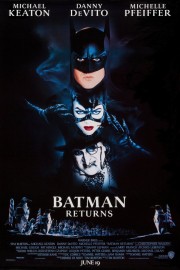Batman Returns
Gee, I can’t imagine why audiences were relatively turned off by Tim Burton’s 1992 sequel to his ridiculously successful 1989 blockbuster, “Batman.” The film only starts with a wealthy husband and wife have a child so grotesque that even the doctors run in terror; so hideous that it’s is kept in a darkened cage, although that doesn’t prevent it from getting its hands on the family cat; and so unbearable that, in the dead of winter, they take its carriage to the river, and they throw him over the bridge. Yes, this is exactly the sort of thing people want to see in a summer movie.
Of course, Tim Burton has never really marched to the beat of the Hollywood drummer anyway, and when he has, it’s never really been good for his unique style. (Just ask anyone who watched his “Planet of the Apes” and “Alice in Wonderland.”) That’s part of why his “Batman” films work as well as they do: by taking the vigilante crime fighter and his Rogues Gallery of villains to their most extreme, surreal form, Burton finds a way to comment on each character in a way few filmmakers are able to do. For all their flaws, Burton’s “Batman” films are just as bold and revolutionary as Christopher Nolan’s current standard-bearers.
When I first watched “Batman Returns” 20 years ago, I was so mesmerized by Michelle Pfeiffer’s powerfully sexual Catwoman that the rest of the film almost felt like filler, and pretty depressing filler at that. But the more I’ve watched it over the years, the story of The Penguin, whose birth and abandonment we see at the start of the film, has come into clearer view. In many ways, The Penguin’s origins are not dissimilar to Bruce Wayne’s early life: parental tragedy struck early for both Wayne and Oswald Cobblepot (Penguin’s actual name), and shaped their life thereafter. The poignancy of Oswald’s life grows with multiple viewings, and through Danny DeVito’s tremendous performance, we feel genuine sympathy for Cobblepot, even though it’s impossible to hide the sociopath he’s become over his 33 years in exile in the sewers, especially when you see him scheming with Max Schreck (Christopher Walken), a Gotham businessman who is every bit as corrupt as the outcast he’s now supporting for a mayoral run.
That being said, however, the film’s primary source of entertainment comes from the brilliant chemistry between Michael Keaton’s Wayne and Pfeiffer’s Selina Kyle, a mousy secretary to Schreck who is thrown out the window by her boss, leading to her transformation into Catwoman. Their scenes together, whether in costume as their alter egos, or on a dinner date as themselves, have a heat and energy that was missing from his scenes with Kim Basinger’s Vicki Vale in the first film. Keaton was always the best Bruce Wayne in the films before Nolan’s trilogy with Christian Bale, as we not only believe him as the playboy billionaire, but also as the haunted soul who would turn to vigilante justice after watching his parents murdered. And Pfeiffer? The always-luminous actress gave herself over completely to Burton’s vision of the role, and she imbued it with dark humor and painful humanity, not to mention an animal magnetism that makes her Catwoman purr with erotic desire. That coupled with Burton’s perverse version of The Penguin, and it’s honestly quite difficult to see how the film ended with with a PG-13 rating; had it not been a Warner Bros.-produced blockbuster, this would have been an R-rated film all the way.
Regardless of rating, “Batman Returns” is anything but your typical Hollywood product– this is the work of a singular artist with every resource at his disposal to make the movie he wanted to make. It’s a bold, provocative work of mainstream moviemaking, and an example of what Burton is capable of when he’s given the chance to do a franchise film his way. Hopefully, he can get back to that way of making movies sooner rather than later.










